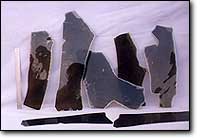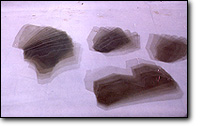FORMS OF PROCESSED MICA
MICA BLOCKS
 Knife
dressed Sheet Mica of a minimum thickness of 0.18 mm (0.007 Inch), is
called Block Mica. Block Mica is obtained in size as large as 30 to 35
cm.sq. (12 to 14 Inches sq) beyond which is practically rare and far too
expensive. It is available in sheets with an average thickness between
0.18 - 0.75mm (0.007 - 0.030 Inch). Block Mica is supplied both in natural
(random) and calibrated thickness as per customers demand.
Knife
dressed Sheet Mica of a minimum thickness of 0.18 mm (0.007 Inch), is
called Block Mica. Block Mica is obtained in size as large as 30 to 35
cm.sq. (12 to 14 Inches sq) beyond which is practically rare and far too
expensive. It is available in sheets with an average thickness between
0.18 - 0.75mm (0.007 - 0.030 Inch). Block Mica is supplied both in natural
(random) and calibrated thickness as per customers demand.
MICA THINS
 Knife
dressed Sheet Mica in any specified range of thickness between 0.05 upto
0.18 mm (0.002 to 0.007 Inch), is called Thin Mica.
Knife
dressed Sheet Mica in any specified range of thickness between 0.05 upto
0.18 mm (0.002 to 0.007 Inch), is called Thin Mica.
MICA CONDENSOR
 Pieces
of high quality Mica having thickness generally less than 2 mils are classified
as Condensor Films. These Films are used in the manufacture of Silver
Mica Plates used in Mica Capacitors.
Pieces
of high quality Mica having thickness generally less than 2 mils are classified
as Condensor Films. These Films are used in the manufacture of Silver
Mica Plates used in Mica Capacitors.
MICA SPLITTING
 Laminae
split from block and thin Mica, the thickness of Ten Sheets of which taken
together does not exceed 0.30 mm (0.012 Inch), is called Splitting Mica.
Splitting Mica chiefly is used in the manufacture of Built-Up Mica or
Micanite products as raw material for ultimate use as an Insulating Material.
Laminae
split from block and thin Mica, the thickness of Ten Sheets of which taken
together does not exceed 0.30 mm (0.012 Inch), is called Splitting Mica.
Splitting Mica chiefly is used in the manufacture of Built-Up Mica or
Micanite products as raw material for ultimate use as an Insulating Material.
MICA SCRAP
 Scrap
mica basically, is a mica that is below specifications and not suitable
for use as sheet mica, because of size, or quality. It is a by-product
of mining, trimming, and fabricating sheet mica. Scrap mica is Classified
and marketed in the following grades:
Scrap
mica basically, is a mica that is below specifications and not suitable
for use as sheet mica, because of size, or quality. It is a by-product
of mining, trimming, and fabricating sheet mica. Scrap mica is Classified
and marketed in the following grades:
Mine Scrap : Scrap mica is obtained in course of cobbing, rifting and dressing crude mica as extracted from the mine, by means of a sickle, as well as, recovered by means of hammer-crushing cross-grained mica which cannot be used as sheet mica for commercial purposes, is classified as mine scrap. It is screened over 1.9 sq.cm (or 0.75 sq.inch) openings, and have an average size between 25-50 mm (1-2 inches), and thickness ranging between 0.25-1.5 mm (0.010-0.060 inches). All mine scrap must be clean, dry , hard, free from mineral and non-mineral impurities, such as: Quartz, felspar, garnet, tourmaline, stones, mud-stained or biotite mica, Clay, sand, as well as, other foreign inclusions, viz:paper, wood-leaves, straw, jute-strings, nails or any other iron-contents etc. It is packed for export in string new gunny (jute) bags containing 50 kilos net weight packings. Mine scrap is primarily used as, paints, electrodes, oil-well drillings, asphalt roofings, tyre, gypsum plaster board etc. Increasing quantities of superior quality mine scrap are now used for manufacturing of mica paper or reconstituted mica as a basic raw material.
Factory Scrap or cuttings: Scrap Mica or mica cutting obtained in course of trimming and dressing sheet mica in the factory by sharp knife, as well as recovered during cutting and stamping sheet mica into pieces of definite size and shape by sear and punch is classified as factory scrap or cuttings. Factory scrap is screened over 1.3 sq.cm (or half inch square) openings, and have an average size between 0.12-0.50 cm (0.5-2 inches) and thickness ranging between .015-0.5 mm (0.006-.020 inches). All factory scrap or cuttings must be absolutely pure, fresh, clean, hard and substantially free from mineral and non-mineral impurities and other foreign inclusions. It is a highest grade and quality of scrap mica, which is mostly used in forming mica paper or reconstituted mica.
India enjoys vast resources and deposits of Sheet Mica and produces worlds finest quality of Mine and Factory Scrap, because all of it is produced in course of Sheet Mica Production. Its present annual output of Scrap Mica is approximately 40,000 tonnes, which is next to the United States of America who are having worlds largest known resources of Scrap Mica with an average annual production of approximately 100,000tonnes. However, the majority of scrap mica produced in the United States is recovered as a by-product or co-product from domestic felspar and kaolin benifications obtained from open quarries, as well as, from other micaceous rocks. They are, therefore, of far inferior quality as compared to Indian grade and quality of scrap mica and are only suitable for use as raw material for ground mica industries. The United States has no economic resources of Sheet mica, its production of sheet mica having declined to almost nil. As a result, its production of superior quality scrap mica, suitable for use in reconstituted mica paper, has completely declined. As such India remains World's primary source of supply of superior grade and quality of scrap mica essential for use in reconstituted mica paper and ground mica Pearlscent Pigment, Cosmetic etc industries.
As
per the forecasts of economic indicators, namely, US Federal Reserve Board
(FRB), based on statistical projections derived from analysis of historical
time series data, it is estimated that the probable world demand for scrap
mica is expected to have an average annual growth rate of 2.5 per cent,
which means, that the present annual world demand of 200,000 tonnes is
likely to be increased to 325,000 tonnes, if not more, by the end of the
century because of steady increase in demand for Ground Mica, Reconstituted
Mica Paper, Pearlscent Pigment, Cosmetic industries etc.
MICA MANUFACTURING CO. PVT.LTD.
3C,
Camac Street, P.O.Box
9052,
Calcutta 700 016 INDIA
Tel: +91-33-2229-2277/2229-4505
Fax:+91-33-2229-5216/2474-7959
E-mail :micamafco@vsnl.net